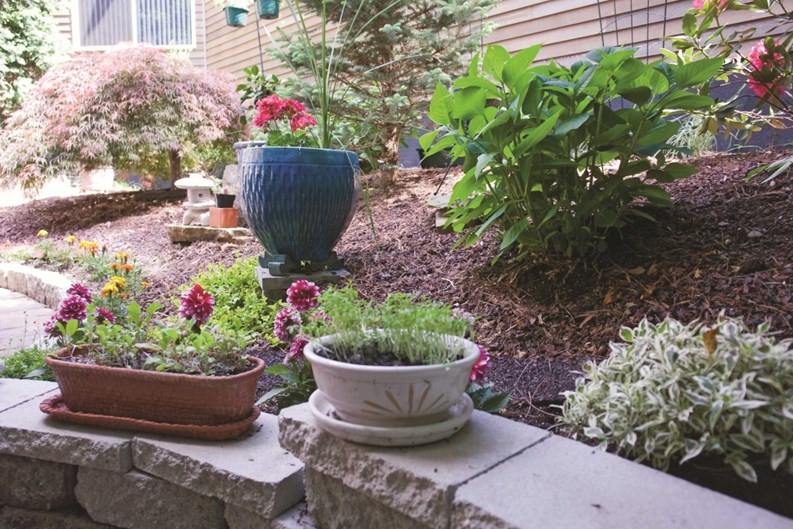As today’s cash-strapped homeowners forego vacations in favor of sticking closer to home (the so-called "staycation") the idea of creating a relaxing, secluded getaway outside their back door is gaining popularity. Even in a spacious HOA where neighbors aren't wedged together cheek-by-jowl, having a sense of remove from the urban or suburban grid is very attractive to many condo owners searching for a quiet haven. A refreshing oasis. A secret garden. A private retreat.
Making Space
Can the front entry, the backyard terrace, or the deck of a townhouse or ground-level condominium be transformed into such a space? Jerry Sarno certainly thinks so. “By having a space designed around the way you like to live, your life will be happier and more enjoyable,” says the architect, developer and builder. So when he planned Deer Path Farms in Hudson, Massachusetts, he incorporated his long-held philosophy that homeowners should be involved in the design process from the beginning—for both the interior spaces and the grounds surrounding their single-family attached townhouses.
The outdoor spaces, Sarno says, “are designed to meet the needs and lifestyles of the people living in the home, what they aspire to, and how they like to use the space.” Mounded earth, evergreens and other features create private spaces for each homeowner.
But the Deer Path Farms philosophy is not necessarily the norm for common-interest communities; most condominium owners don't have a hand in designing their spaces from the start. One of the bigger challenges facing condo dwellers longing for that private retreat is that HOAs vary widely in terms of how much land they have available, as well as the restrictions placed on that land. While a good designer can often do wonders with even a small plot, any work customizing exterior space around an individual condo has to comply with an array of constraints. Design professionals advise owners to look into those constraints and answer some important questions long before anybody puts spade to soil or starts shopping for planters at the local garden center. Are residents allowed to plant privacy shrubs on their property lines? What about fencing? What are the association's rules about bringing contractors onto the property? A conversation with your property manager can help clear up questions like these and insure that your project is being carried out within the rules.
According to Attorney David J. Byrne of the Lawrenceville-based law firm of Stark & Stark, New Jersey condominium law defines what is the owner's space and what belongs to the condominium collectively.
"In a condominium, all space outside is typically common element. In a HOA, all space outside is typically part of the owner's 'lot' that he owns in fee simple," says Byrne. "Often though these spaces are handled, and are operated, the same way. The immediately surrounding exterior space in a condominium is often a 'limited common element,' with respect to which that owner is given the right of exclusive use and control subject to
the condominium's right to adopt and enforce reasonable rules and regulations. The condominium owner enjoys the space exclusive to all others, even though it technically remains common element. That all,
for all practical and appearance purposes, resembles the immediately exterior space in a HOA," he says.
What do unit owners need to know before starting a project? Byrne says that "owners in both types of associations must review their governing documents to determine what exactly is relevant for legal purposes. Owners must thereafter consult with their associations as to the precise mechanism—if any—to create an outdoor green space. Depending on what is desired, some condominiums require the creation and execution of a restrictive covenant, setting the rights and obligations of the owner and condominium going forward" and all of that is typically recorded against the master deed, adds Byrne.
After determining what can and can’t be done, it’s time to let the imagination loose and decide exactly what kind of outdoor space you'd like. For example, when Parsippany-based Davies Associates Landscape Architects LLC was hired by the Chestertowne Townhouses condo association in Chester to design a fresh landscaping plan, company president Bruce John Davies decided that personalization was key. “This was a group of about 24 large units where the homeowners had all owned houses before, so we designed custom plantings for each unit to suit their tastes individually. The project benefited everyone as a whole.”
Plant for Your Space and Follow the Rules
Not all condo owners have free rein to build a custom outdoor space, but a professional landscape designer—easily recognized by an affiliation with the Association of Professional Landscape Designers—will have the “eye” needed to see what can be done within the bounds of a client's association parameters. Everyone has their own special ‘wish list,’ and a designer can often figure out how to make it work. Even if your space is not large, say the landscapers, there are ways to create private areas for different functions—for dining, for relaxing, or a place for kids to play. Even a narrow swath of lawn or a small patio can be turned into an inviting, intimate environment through the use of attractive containers, beautiful furniture and well-placed paving materials.
Byrne adds that there are restrictions as to what New Jersey condo owners can do to create their own "private" landscaped oasis. Unit owners should consult with their association before embarking on a project that may be against the governing documents, bylaws or house rules. Byrne says that "members are typically denied the right to alter the landscaping with respect to the common elements and common property of an HOA." Although, he says, a condo owner "is often given the right to alter the landscaping in his 'limited common element' subject to the condominium's right to adopt and enforce reasonable rules and regulations," an owner can make changes in his or her own backyard but again subject to the HOA's rules and regulations. "To the extent that the particular association is required to maintain the landscaping in a limited common element, or on an individual lot in a HOA," says Byrne, "that association often limits the discretion of the owner so as to avoid an unreasonable burden on the association's landscaper."
The professionals interviewed for this article agree that one key element to a successful private outdoor space is working with plants that perform well within the given setting. That means choosing plants that won’t outgrow the space, require constant maintenance, or drive the neighbors nuts by attracting insects or shedding fluffy seed-pods onto their lawn. It’s all too easy for homeowners to see a cute little tree in a nursery, and not visualize what that tree will look like in five or ten years. An experienced, competent landscape designer will plan with the mature plant in mind, and help avoid planting a four-story tree in a tiny railroad back garden plot.
Ideas are Limitless
It may be hard to imagine that little patio or deck area as a lush garden—but that’s where the professionals come into play.
“If it’s a raw site, the landscape architect works with the building architect and we look at the topography, solar gain, trees, and so forth,” says Thomas Tavella, ASLA, vice president of the BSC-Group, in Glastonbury, Connecticut. “If it’s an existing development we’ll look at the perimeter of how the house sits, the trees that are there and existing living space or pools on the property.”
Landscape designers also use color and texture to make smaller, private green spaces more vibrant and visually interesting—after all, color doesn't take up space. "Color is key and relies heavily on seasonal flowers and annuals," says one landscape designer in Allendale. "Eye-catching masses buoy the spirits of residents and passersby. We have many clients choose pansies for early color with impatiens, begonias and petunias for an upbeat spring look. Icicle pansies, flowering cabbage and mums are planted in the fall, and container plantings can be incorporated for additional color and interest."
Beyond that, there are a host of special touches that can add a little extra magic. "I love to incorporate fragrance into gardens. To me, fragrance is a really special thing," says Madelyn Simon, CEO of Madelyn Simon Associates, a Manhattan-based firm that specializes in interior and exterior plantscapes. "And water features are wonderful." Another way to lift a smaller outdoor area beyond the ordinary is to create a theme. Simon describes a particularly beautiful and relaxing backyard garden they created with 40-foot bamboo, a shallow koi pond with a little bridge going over it, and a secluded meditation garden in the back. A few minutes spent there would give a lift to anyone’s day.
The association does have a say about the landscaping. But the board—of which Sarno is chairman—works with owners to help accomplish their goals while maintaining the cohesive appearance of the community. “The association helps with things an owner can’t do; in many cases, the association has done the work gratis because the owner is also enhancing the community,” he says.
An upside to homeowners beautifying their little plot of land, he notes, is that “it becomes contagious. People share seedlings and cuttings.”
Drawing the Line
But that doesn’t mean that “anything goes,” even in a community that encourages a homeowner’s dreams. Byrne agrees and said that the bottom line with any improvement or alteration always rests with the HOA board. The Deer Path Farms board, for example, wasn’t enthusiastic about vegetable gardens around the homes. But recognizing that people are increasingly conscious about the freshness and quality of their food, the board compromised by designating a private area where vegetables can be grown, without infringing on the appearance of the homes with swaths of churned-up sod, tomato cages, and mounds of compost fertilizer. Thus they provided a perfect balance ensuring both the HOA's harmony and the natural environment.
Pat Gale is associate editor at New England Condominium magazine, a Yale Robbins, Inc. publication.





Leave a Comment